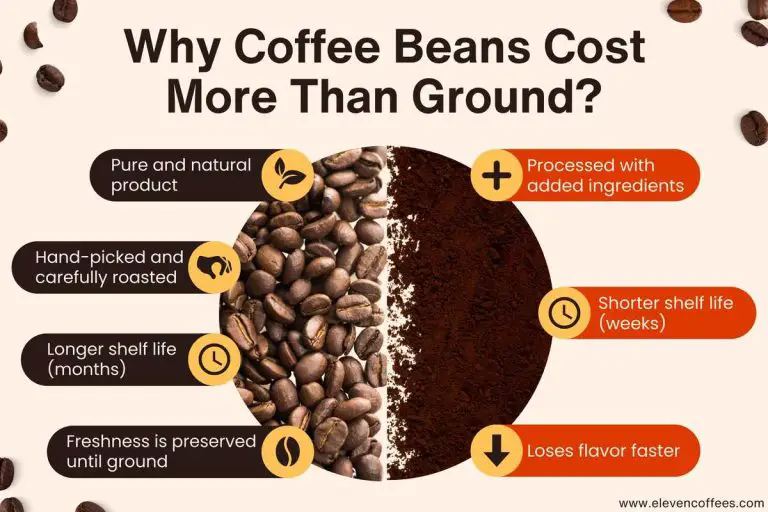Can I Use Coffee Beans for Espresso?
As any coffee connoisseur knows, regular coffee beans and espresso beans are quite different.
Whether you’re an espresso lover or you just have some extra coffee beans lying around, you may be wondering if you can use regular coffee beans for making espresso.
You can use coffee beans for espresso. Espresso beans and coffee beans are the same bean, the only difference comes in the roasting and grinding. The best beans for making espresso are medium-roast and have a small grind size.
In this article, I’ll talk about using coffee beans for your espresso, why it can cause problems, and whether or not it is worth a try.
What Happens If I Use Coffee Beans for Espresso?

You can certainly use regular coffee beans for making espresso.
In fact, talking about “espresso beans” and “coffee beans” doesn’t make much sense: they are the same bean.
The difference comes in how they’re processed—more on that later.
For now, you should know that the main factors affecting the quality of your espresso is the grind size and the preparation method.
However, if you have a coffee grinder and know how to make a proper espresso, you should start paying attention to the type of coffee that you buy.
Espresso beans can indeed make better espresso, and if you use regular coffee beans in your espresso machines, you might run into some issues.
Oily Beans Can Ruin Your Espresso
Coffee beans become more oily the more they get roasted. This is by no means a bad thing—it’s part of what makes coffe taste like it does.
As coffee beans get roasted, they become more porous, and this allows its natural oils to be released.
These oils can enhance your coffee’s flavor, but too much of it can make it taste rancid.
Here’s where selecting the espresso beans may matter. Espresso beans from reputable brands should have the right roast.
However, regular coffee beans might be too dark and oily for making a good espresso.
First, let’s consider how your espresso will taste if ou make it with oily beans.
The first few times you try it, you may notice a burnt taste in your coffee and it willleave a bad taste in your mouth afterward.
Too much oil doesn’t just affect the taste of your coffee, though. If there is too much oil in the beans, the excess oil can stick to your espresso machine.
This can cause it to clog, become unusable, and even alter the flavor of future espressos.
If you have ever cleaned a pan after cooking with oil, you know it can be challenging to remove it if it’s left there too long.
The same applies to your espresso machine. The oil that you leave uncleaned can build up and become a problem.
Oil buildup can also change the flavor of your espresso. As the oil sits in the espresso machine, it will begin to rot.
This means that the next time you use the espresso machine, some of that rotted oil can easily make its way into your cup.
This can make your espresso taste awful and leave you wondering what you did wrong.
How Is Coffee Different from Espresso?

Let’s break down the difference between regular coffee and espresso to help you understand how using coffee beans to make espresso can change the flavor.
To start, espresso beans are the same as coffee beans. The difference comes in the process of roasting and grounding the beans.
Longer Roasting
The first main difference between coffee and espresso beans comes in during the roasting process.
It is imperative to roast espresso beans longer than coffee beans.
While you can choose coffee beans with any level of roasting, espresso beans need to be dark.
Allowing the espresso beans to roast longer adds a richer flavor to the finished product.
This rich flavor might be missing if you use ordinary coffee beans instead of espresso beans.
This doesn’t necessarily mean that any dark roast coffee beans will work fine for your espresso machine. In fact, you can roast espresso beans for too long.
Even if the coffee beans are dark roast beans, there is a chance the manufacturer roasted them more than they should..
If the manufacturer roasted the coffee beans for too long, they could actually produce too much natural oil, which can clog your grinder and change the overall flavor of the coffee.
Be careful when choosing the right beans for your espresso machine, as dark roast doesn’t guarantee that it will give you a high quality espresso.
Grinding

Another important distinction between coffee and espresso beans is consistency.
Typically, manufacturers grind espresso beans finer than coffee beans to help ease the brewing process.
If you’re grinding regular coffee beans for making espresso, make sure to grind them a bit finer than normal to achieve better consistency.
When you use an espresso machine, you are pushing water through the ground espresso beans very quickly.
In total, brewing espresso takes about 30 seconds.
There is not a lot of time for the water to come in contact with the espresso beans.
If you don’t use beans ground to the right consistency, the flavor of your coffee won’t be as intense.
Getting the right grind for your coffee beans is probably not all that challenging if you have a grinder at home.
For the best possible espresso, you will want the grind size to be about 0.3 millimeters.
If you don’t grind your coffee and espresso beans at home, your best bet is to find pre-ground espresso beans or at least regular ground coffee with a small grind size.
Either way, the grind size will make a huge difference in how strong and flavorful your espresso is.
How to Choose the Right Coffee Beans for Espresso

While a dark roast that is too oily can cause the issues we discussed above, that doesn’t mean a light roast is better for your espresso.
The ideal espresso beans have a medium to medium-dark roast.
Dark enough to release an intense, bitter flavor, but not dark enough to become oily.
It is important to note that light roasts have a lot less oil but more caffeine, as some caffeine cooks away during the roasting process.
If you want a strong caffeine boost, you may want to use light roast coffee beans for your espresso.
If you do, just know that you will not get the rich flavor you may be expecting.
As you get further down the scale to medium roasts, you will have better luck with using your coffee beans for espresso.
Medium roast coffee beans roast for a longer period than light roast, which means more oil has had the chance to come out and produce a strong, rich flavor.
There are many espresso fans who love using light roast coffee beans to make their espresso, but they have to make some adjustments to ensure there is still plenty of flavor.
Making Espresso With Light Roast Beans
First, check the grind on the beans you are using for your espresso machine. This is the key for producing a good-tasting espresso.
However, if you want to get a good espresso out of your regular coffee beans, you’ll have to play around with the consistency.
Try finer or thicker beans to see if they produce a better taste.
Once you have the right consistency for your light roast beans, you may need to consider the brewing temperature and time.
To extract the most flavor from your light roast beans, consider brewing at a higher temperature and for a longer period.
This can help you truly capture the flavor of your beans, but you need to be careful not to burn them.
To avoid burning your roast, try to change the temperature in small increments.
Normally, you would brew your dark roast around 190 F (88 C), while you would brew your medium roast right around 200 F (93 C) when making an espresso.
You can bump the temperature to 205 F (96 C) for light roast beans without much risk.
This temperature adjustment isn’t going to work for every type of bean or espresso machine out there.
Play around some with different temperatures to find the right one for your light roast beans.
Finally, you may need to slightly adjust the brewing time of your light roast coffee to get a rich-flavored espresso.
The brewing process for an espresso usually takes around 30 seconds, and adding just a few seconds can alter the flavor of your drink.
If you aren’t satisfied with the espresso produced by your light roast beans, try brewing them for a few seconds longer.
Do Coffee Beans or Espresso Beans Have More Caffeine?

An espresso shot has an intense, bitter flavoir that has led many of us to believe that it’s also higher in caffeine than the regular cup of coffee.
However, the truth is that coffee beans tend to contain more caffeine than espresso beans.
The reason for this comes down to the roasting process. As we discussed, manufacturers roast espresso beans for longer periods to bring out the oils in the beans and enhance the flavor.
Darker roast coffee beans contain less caffeine than other types because the caffeine burns off during the roasting process.
The less time a coffee bean roasts, the more caffeine it will have.
Most espresso beans are medium-dark roast beans, wich means that a shot of espresso actually has less caffeine than other types of coffee.
This is such a common misunderstanding that people buy dark roast beans looking for an extra boost of caffeine.
However, if you truly want more caffeine in your coffee or espresso, you need to find beans with a lighter roast.
The Brewing Method Affects Caffeine Levels
However, the differences in caffeine content between types of coffee beans is minimal when you compare it with the effect that different brewing methods have on it.
To put it simply, the longer the coffee beans are infused in water, the more caffeine they will release.
This means that espresso, due to its short brewing time, has a low caffeine content when compared to other methods such as the French press or filter coffee.
Can You Use Espresso Beans for Coffee?
You can use espresso beans to make ordinary drip coffee, but it might change the flavor of your coffee.
Using finely ground espresso beans will make your coffee taste stronger.
As discussed above, the only differences between coffee beans and espresso beans are the roasting time and grind size.
You can expect espresso beans to be finer than coffee beans, and this affects what happens during the brewing process.
Finer beans create a more flavorful brew. Using espresso beans for your drip coffee machine will make the final product taste stronger, which probably won’t be a problem for coffee fans.
For preground espresso beans, consider brewing them for a shorter amount of time.
This will make the flavor less strong. Alternatively, you can simply add more water to the finished brew.
Keep in mind that espresso is a method of preparing coffee, not a type of coffee bean.
No matter which type of coffee beans you use, you will only get an espresso if you use an espresso machine.
Espresso is prepared by forcing almost boiling water through tightly pressed, finely ground coffee beans.
This produces a layer of foam and a rich flavor that you won’t get with a drip coffee machine.
Final Thoughts
Technically, there is no difference between espresso and coffee beans.
Espresso beans are simply coffe beans that have the right roasting and grind size for making espresso.
You can use both types in different methods without much worry.
Just know that you may alter the flavor by using coffee beans with espresso or vice versa.
Your best bet for using coffee beans to make espresso is to try different brewing temperatures and times to see what works best with your gear.
You may need to try to play around a bit before you get the perfect brew.
Sources
- Home Grounds: The Difference Between Coffee and Espresso Beans (Yes, There’s a Difference)
- Coffee Improved: Are Espresso Grounds Just Finely Ground Coffee? Difference?
- Espresso Canada: How Oily Coffee Beans Can Ruin Your Espresso Machine and Coffee Taste
- Eleven Coffees: Which Coffee Has the Least Caffeine?
- Just Coffee and Me: Can You Use Espresso Beans for Drip Coffee? Myth Busted







